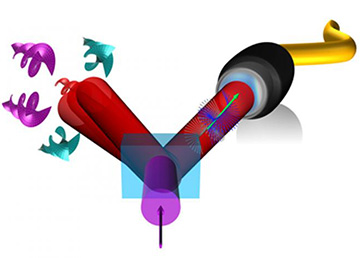
Multidimensional” entanglement can be achieved by entangling one photon in polarization and the other in orbital angular momentum, even though the former travels along single-mode fiber. [Image: Wits University]
If the classical internet of today is anything to go by, tomorrow’s quantum internet will put a premium on network bandwidth. So it would be very handy if entangled states could be transported via existing fiber optic cables at the highest bit rates. Researchers in South Africa and China reckon that should now be possible (Sci. Adv., doi: 10.1126/sciadv.aay0837).
Quantum communication
Entanglement involves a bizarre interconnection between two quantum particles, such that even if they are far apart, a measurement of one will instantaneously change the state of the other. This phenomenon is exploited, for example, in quantum key distribution, which involves two distant parties sharing a secret key in order to encrypt and decrypt messages with complete security—the idea being that any eavesdropper would reveal their presence by altering the key’s quantum state.
Much quantum communication currently relies on entangling photons via polarization—their spin angular momentum. But each photon can only encode one bit of information—a superposition of “1” and “0”—which limits bandwidth. To go beyond this, scientists would also like to entangle photons via spatial properties such as orbital angular momentum (OAM). That involves twisting a light beam’s wave front around its direction of propagation so that it takes on a corkscrew shape, with the degree of twist, in principle, able to take on an infinite number of possible values. This would allow for packing a lot more information into photons.
However, while spin entanglement can be transported along the single-mode fibers that form the backbone of today’s internet, its orbital counterpart requires customized multimode fiber. Even then, cross-talk between the different modes has limited transport of orbital entanglement to less than a meter.
Entangling polarization with OAM
The latest work sees a compromise between the two. OSA Fellow Andrew Forbes and colleagues at the University of the Witwatersrand, South Africa, together with Jian Wang and co-workers at the Huazhong University of Science and Technology in China, do this by entangling the polarization of one photon with the OAM of another. They send the two photons down a channel—the former along a 250-meter stretch of single-mode fiber and the latter through free space.
When the photon states are measured, each registers a particular value, but while in transit they exist in a superposition of all possible values. By multiplexing the optics, explains Forbes, every combination of spin and OAM (or spatial “patterns”) can be transmitted.
“It looks to the receiver as if the patterns themselves must have got across the channel too, which they did, but two at a time,” he says. “The strange thing is that the fiber part of the channel only supports one pattern, but we can trick it into working because of the fact that entanglement means nothing is certain until you measure, and we only measure after we have sent the photons through.”
Work to be done
The researchers describe their approach as “multidimensional” entanglement, to distinguish the multiple two-dimensional states that it produces from the single high-dimensional state that would be sent through multimode fiber. Forbes says that their next step is to develop new protocols to exploit their technique, which, he believes, could potentially multiply the bandwidth of normal fiber by a factor of several hundred. In addition, he adds, they aim to carry out tests over much longer distances—up to 100 kilometers.
Forbes says that multidimensional entanglement is not a new concept, pointing out that a quantum computer does its calculations using multiple 2D states—its quantum bits—rather than a single high-dimensional state. “We need to play similar tricks with quantum communication,” he says. “This work is the beginning of a new approach, with lots of work to be done.”
